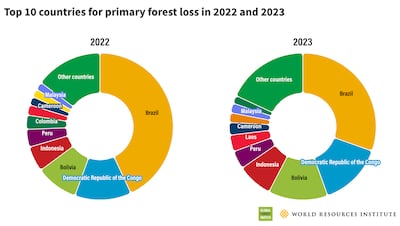Coffee consumption around the world is estimated at about 173 million 60kg bags a year, or roughly two billion cups a day.
The International Coffee Organization forecasts that in 2023-2024, consumption will rise to 177 million bags.
But just what does the world’s seemingly insatiable demand for coffee mean for the environment, and in particular biodiversity, given that the crop is often grown on land that was once forested?
According to the Coffee Barometer 2023 report, produced by an initiative supported by Conservation International, over the past two decades an average of 130,000 hectares of forested land a year has been converted to coffee production.
Aside from the impact this has on biodiversity, this deforestation has also released the equivalent of about 45 million tonnes of carbon dioxide each year.
A big issue for sustainability is whether the coffee plants are grown as a single crop or are mixed in with trees that provide shade, a practice known as agroforestry.
According to the Coffee Barometer, agroforestry can, among other things, store carbon and promote biodiversity, and so replicates, at least to a limited extent, the benefits that forests bring.
Agroforestry, thanks to the shading and the microclimates it creates, is also more resilient than single crop plantations to temperature increases.
Growing in harmony
Few have looked into the sustainability of coffee more closely than Sander Reuderink, a Dutch former coffee roaster and trader who is the founder and chief executive of Carble, which analyses land-use changes – such as the conversion of forests to plantations – and develops incentives to encourage farmers to grow more sustainably.
Mr Reuderink said coffee “can be grown in perfect harmony with nature”.
“That’s what we see in Ethiopia,” he said. “The first time I visited a coffee farm in Ethiopia, I didn’t know what I was looking at, because I had expected to see neat rows of trees like on a coffee farm in Brazil, but I was looking at a forest.
“I asked the farmer to explain to me what was going on, what I was looking at. He explained, ‘This is how we’ve been growing coffee for generations. This is how coffee should be grown.’
“But in other countries coffee is grown in a monoculture without the use of shade. Especially the transition from forests to new plantations is hugely problematic from an environmental perspective. That land-use change is one of the biggest components.
“Another really big component is the use of fertilizers and pesticides, which have a very large carbon footprint.”
A widespread perception might be that smallholders, who account for an estimated 80 to 90 per cent of coffee production, grow their coffee more sustainably than large-scale producers.
Mr Reuderink said, however, that the opposite is often the case, while adding the caveat that smallholders are “a very diverse group”, so practices vary widely.
“The assumption that I always had was that industrial farms or larger farms would produce in a monoculture, while smallholders would do more agroforestry. Surprisingly this was not always true,” he said.
“For example, in Ethiopia, we’ve actually seen much healthier shade cover with the larger plantations than with the smallholders.”
Sustainability is also influenced by the extent to which native forests were felled to allow for the growing of coffee and, if so, how long ago this happened.
While indicating that efforts to achieve sustainability vary between coffee companies – Nestle and Starbucks tend to come out better than most in its surveys – Coffee Barometer said many companies did not address the issue themselves, but instead “placed the responsibility on suppliers to ensure deforestation-free coffee”.
“Very few roasters have policies that meet best-practice requirements,” the 2023 report said. “While some individual companies may be performing better than others, our Coffee Brew Index reveals that most companies are not yet taking the action necessary to fulfil the existing sector commitments in addressing social and environmental risks.”

The larger, the better?
Mr Reuderink said that, in general, larger coffee companies were more focused on achieving environmental producers than their smaller counterparts.
“The mainstream companies, the larger companies, they typically have a much more advanced climate strategy than the small-scale specialty segment. The specialty coffee brands, they like to talk a lot about sustainability, but they do very little on the ground,” he said.
Commercial coffee production largely originated in Ethiopia, but one of the other early producers was Yemen, which has grown coffee commercially since the 15th century.
Coffee is also grown in Saudi Arabia, which has more than 400,000 Arabica coffee plants, according to reports, and plans for big increases.
In 2022, the Saudi Coffee Company was founded to help develop the sector in the country. Its production, mostly by smallholders and local farmers, is concentrated in the south-west of the country.
Dr Abdullah Bokhari, the sustainability and quality, health, safety, security and environment director, said that the company was currently assessing its overall sustainability, including efforts to reduce deforestation and deal with carbon dioxide emissions.
Scheduled to take about two years, this work will cover farming, manufacturing and distribution.
Current measures include having irrigation systems that rely on solar power instead of diesel pumps, while a factory will be solar powered and designed to achieve green building certification.
“Additionally, we have used green materials in compliance with regulatory requirements, and have adopted waste-reduction practices for our farming and factory operations,” Dr Bokhari said.
On the ground
For consumers, selecting a coffee on environmental grounds may not be easy. One approach is to look for certifications.
“There’s lots of different certifications out there – fair trade or sustainable coffee – but these are very patchy,” said Mark Maslin, a professor of earth system science at University College London.
He recommends that consumers purchase “quality coffee” because with this, he said, it is more likely that farmers will have been paid a fairer price.
“It won’t make much difference to [the price of] your coffee, but it will make a huge difference to the farmer and the industry,” he said.
Mr Reuderink said not all environmentally sustainable coffee was certified as such and, when looking for more sustainable coffee, he said he made his selection based on geography.
The Coffee Barometer 2023 report does not have figures for Ethiopia, but for Brazil it states that five per cent of coffee-growing hectares are shaded, while in Vietnam the figure is 25 per cent, in Colombia, 39 per cent, in Indonesia, 60 per cent, and in Honduras, 80 per cent.
“I choose based on countries, such as Ethiopia, that I know grow more of their coffee in agroforestry, because that’s more sustainable,” he said.

